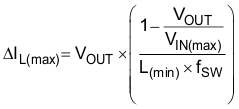JAJSBR5H February 2012 – June 2018 TLV62130 , TLV62130A
PRODUCTION DATA.
- 1 特長
- 2 アプリケーション
- 3 概要
- 4 改訂履歴
- 5 Device Comparison Table
- 6 Pin Configuration and Functions
- 7 Specifications
- 8 Detailed Description
-
9 Application and Implementation
- 9.1 Application Information
- 9.2 Typical Application
- 9.3 System Examples
- 10Power Supply Recommendations
- 11Layout
- 12デバイスおよびドキュメントのサポート
- 13メカニカル、パッケージ、および注文情報
パッケージ・オプション
メカニカル・データ(パッケージ|ピン)
- RGT|16
サーマルパッド・メカニカル・データ
- RGT|16
発注情報
9.2.2.3.1 Inductor Selection
The inductor selection is affected by several effects like inductor ripple current, output ripple voltage, PWM-to-PSM transition point and efficiency. In addition, the inductor selected has to be rated for appropriate saturation current and DC resistance (DCR). Equation 7 and Equation 8 calculate the maximum inductor current under static load conditions.
spacing


where
- IL(max) is the maximum inductor current.
- ΔIL is the Peak to Peak Inductor Ripple Current.
- L(min) is the minimum effective inductor value.
- fSW is the actual PWM Switching Frequency.
spacing
Calculating the maximum inductor current using the actual operating conditions gives the minimum saturation current of the inductor needed. A margin of about 20% is recommended to add. A larger inductor value is also useful to get lower ripple current, but increases the transient response time and size as well. The following inductors have been used with the TLV62130 and are recommended for use:
Table 5. List of Inductors
| Type | Inductance [µH] | Current [A](1) | Dimensions [LxBxH] mm | MANUFACTURER(2) |
|---|---|---|---|---|
| XFL4020-102ME_ | 1.0 µH, ±20% | 4.7 | 4 × 4 × 2.1 | Coilcraft |
| XFL4020-152ME_ | 1.5 µH, ±20% | 4.2 | 4 × 4 × 2.1 | Coilcraft |
| XFL4020-222ME_ | 2.2 µH, ±20% | 3.8 | 4 × 4 × 2.1 | Coilcraft |
| IHLP1212BZ-11 | 1.0 µH, ±20% | 4.5 | 3 × 3.6 × 2 | Vishay |
| IHLP1212BZ-11 | 2.2 µH, ±20% | 3.0 | 3 × 3.6 × 2 | Vishay |
| SRP4020-3R3M | 3.3µH, ±20% | 3.3 | 4.8 × 4 × 2 | Bourns |
| VLC5045T-3R3N | 3.3µH, ±30% | 4.0 | 5 × 5 × 4.5 | TDK |
spacing
The inductor value also determines the load current at which Power Save Mode is entered:

Using Equation 8, this current level can be adjusted by changing the inductor value.